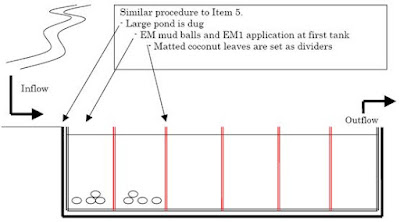Introduction
The earthquake and the ensuing tsunami
that struck several countries around the Indian Ocean on Dec. 26, 2004 have
left more than 150,000 people dead and missing. As rescue and rehabilitation
operations continue, there are several problems that need to be addressed.
Among these are foul odor remediation and infectious disease control due to
rotting corpses as well as the lack of safe drinking water and salinity in the
soil of many inland areas struck by the tsunami.
In
line with these issues, herewith are some practical suggestions for the
application of EM Technology for the rescue and remediation efforts in the
disaster struck areas. It must be noted that these are temporary measures.
Salinity control
As the waves swept inland, many freshwater sources and soil areas have been
mixed with the water from the ocean. This has left many farms such as rice
paddies or shrimp ponds with extreme salinity. In order to reduce the salinity
of the food production areas, the following are suggested.
A. Spray with EM Activated Solution: The EM microbes can
absorb and store in their bodies the minerals brought in by the seawater and
kept in the soil. The minimum recommended application is EM Activated Solution
diluted 1,000 times sprayed at 1 L/m2 at least once a week. If possible, it is
also recommended to spread bokashi to the food production point (that is, farms
or garden plots) to help the EM and other local beneficial microbes increase in
the area and hence reduce more quickly the salinity in the soil.
B.
For rice paddies and shrimp ponds
- Apply bokashi as suggested in
the APNAN guidelines for land preparation
- Plant
rice. This crop has a high salinity absorbing capability. It is expected
that one cycle can help decrease significantly the salinity in the soil.
- Change
water regularly as the usual practice in growing rice.
- In
the case of areas where there is no water (as in a paddy), wheat, barley,
etc. can be planted since these crops have high salinity absorbing
capability.
Foul Odor Control
There is much foul odor emanating from the decaying bodies. Spraying of EMAS,
preferably at a dilution rate of 1:30-50 is suggested. For an area in general,
spraying twice a day is also recommended to help reduce the chance of the
spread of infectious diseases.
Obtaining water for general use (not for drinking): Making a simple filter
For drinking water
Many military engineering corps have their own drinking water conversion and
treatment systems. It would be much quicker to use such systems to obtain
drinking water. Commercially available treatment systems are also available,
such as reverse osmosis systems with 5 filter layer systems and can only filter
about 550L per day and costs about 70,000 baht per unit (in the case of
Japanese brands in Japan). Nonetheless, a simple filter system can be made as
follows:
Obtaining
water from open water sources, such as rivers, other freshwater
/ brackish water sources.
Obtaining
water from open water sources, such as rivers and other freshwater bodies (for
general purposes, not for drinking).
For
making of EMAS
It is preferable to use clean/drinking quality water for making of the EMAS.
However, in case it is difficult to obtain clean water, brackish water can be
used. In the case brackish water supply is limited, brackish water (50%) and
sea water (50%) can be used. The use of 100% seawater is not advised.
For malaria control in freshwater bodies
It is possible for malaria and other waterborne diseases to break out from unclean freshwater sources. As countermeasure, the following are suggested:
For malaria control in freshwater bodies
It is possible for malaria and other waterborne diseases to break out from unclean freshwater sources. As countermeasure, the following are suggested:
- Spray EMAS - Initial
application: 1:2000 of water volume - Next applications:
1:5,000-10,000 of water volume
- Apply mud balls (not bokashi
balls) into the ponds at a rate of 1 pc/m2
Others
- Toilets: In the case of
makeshift toilets, EMAS can be sprayed for foul odor control and
suppression of pathogenic microbes.
- Bath/shower alternative: Mix at
least 1% of EMAS or EM1 to water. Wet a hand
towel and apply to the body. If 1% of EMAS is not effective, a more concentrated EMAS dilution, (up to 10%) is recommended. It must be noted too that the body of some people may initially react to the EMAS application. Itchiness, redness of the skin may be experienced. If it is too much to bear, it is recommended that the person stop this application.
Rainwater: Collected rainwater may
be used for general purpose as well as for drinking. EM application can be as
follows:






No comments:
Post a Comment